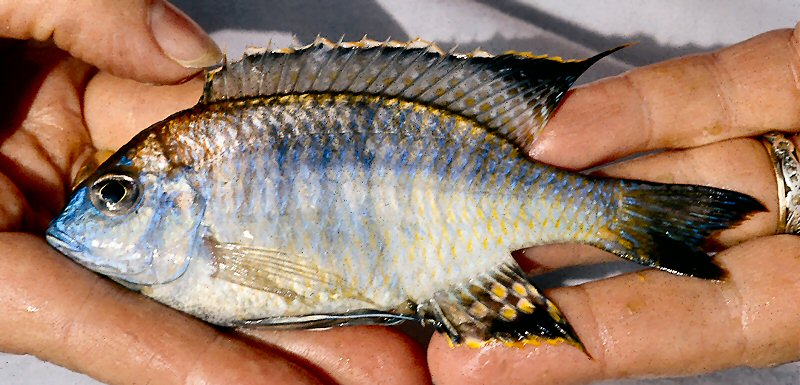

Lethrinops turneri
Above: Lethrinops turneri was given its scientific name in an April 2003 publication (Ngatunga and Snoeks, 2003). The name honors British biologist Dr. George Turner, Professor at the University of Hull — and Guest Author of several recent species pages at this Web site (see Latest Changes window). The photo shows an individual trawled at station Namiasi-White Rock on 21 October 1991, in a depth of up to 28 m (~90 feet); this specimen is not among the type material and was of unrecorded length. Photo by George Turner, used with his kind permission.
Lethrinops turneri occurs both in southern Lake Malawi, where it is known as far north as Domira Bay, and in Lake Malombe (just south of the southeast arm of L. Malawi, with which it is connected by the upper Shiré River). The holotype (RUSI 60072, Rhodes University), a male 77 mm in standard length (SL, excluding caudal fin), was seined on Mvera beach in L. Malombe. The largest specimen in the type series is a male 94 mm (3.7 inches) in SL and about 120 mm (4.7 inches) total length.
In his book on the offshore cichlids of L. Malawi, Turner (1996) included this species as Lethrinops 'pink head.' Indeed, the patch of orange-brown, on the upper part of the head and on the nape (between the head and the front of the dorsal fin), is the easiest way to recognize adult males. Ngatunga and Snoeks assigned L. turneri to "a group of shallow-water Lethrinops characterised by a short snout (20.0-35.8 % HL [head length]), with a terminal mouth set low on the profile, a small adult size (<140 mm SL) and, in most members, the possession of a few enlarged teeth at the postero-median part of the lower pharyngeal bone." The other members of this group are the previously described species L. parvidens, L. auritus, L. microstoma, L. macrophthalmus, L. macrochir, and still-undescribed species known as L. 'parvidens deep,' L. 'domira blotch,' and L. 'black dorsal auritus.' Several differences in proportions also distinguish L. turneri from these similar forms, but the aforementioned orange-brown color patch of mature males is the most straightforward diagnostic feature.
Even though it was not formally described till 2003, Lethrinops turneri is an abundant fish. Turner (1996) reported that, during 1990, seine nets in Lake Malombe caught more than 2500 tons of this species, which is the most important food fish in that lake. The average individual, Turner estimated, weighs 3 grams. Therefore, he reasoned, the annual catch of this species in Lake Malombe is around 850 million fish! Oddly, the most abundant fish in Lake Malawi was also only recently described; Diplotaxodon limnothrissa was named by Turner in 1994.
Some individuals of Lethrinops turneri less than 60 mm TL are mature. The clutch size is about 30 eggs per batch. Based on examination of only a few stomachs, the diet includes chironomids, copepods, chaoborus larvae, ostracods, nematodes, diatoms, odonates [dragonflies and damselflies — probably larvae?], and cladocerans (Turner, 1996). Ngatunga and Snoeks also reported algal remains, detritus, and sand in all stomachs.
Lethrinops turneri has probably never been exported as an aquarium fish.

| Page first posted: 22 June 2003
Web Author: M. K. Oliver, Ph.D. Copyright © 1997-2021 by M. K. Oliver, Ph.D. - ALL RIGHTS RESERVED |